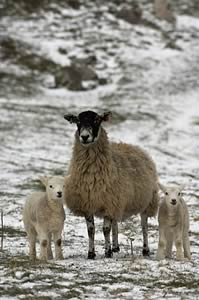| 2009-07-27
Breeding offers a valuable way of reducing the prevalence of footrot in UK flocks, helping to minimise the costs of effective management control. However, given the general ineffectiveness of the genetic marker test developed in New Zealand to accurately pinpoint footrot resistance in UK breeds, this is currently best based on EBVs from ewe hoof scoring.
These are the key findings of a comprehensive four year Defra Sustainable Livestock Production LINK Programme project led by SAC with support from EBLEX, the industry body for beef and lamb levy-payers in England.
The project involved more than 55,000 individual hoof scores from nearly 14,000 Texel, Scottish Blackface and Mule sheep in 27 mainly commercial flocks with pedigree information from 2005 to 2007, coupled with blood sampling for molecular genetic analysis.
The extensive scoring shows the average prevalence of footrot and its precursor conditions varies widely between both breeds – from 17% to 57% – and farms – from less than 1% on some to nearly 60% on one unit. At the same time, older ewes, ewes rearing twins and male lambs are identified as being at particular risk.
Analysis of the disease and pedigree data reveals footrot has a low to moderate heritability in adults, confirming that conventional breeding approaches can be used to improve resistance and assist in its control. It also underlines that breeding for resistance will give greater and more rapid results in flocks with high levels of footrot, and that ewes should be scored more than once – ideally at the same time each year – for the most accurate EBV development.
Further genetic analyses show footrot resistance is usually either favourably correlated with other traits or uncorrelated with them. This means that breeding for resistance will not compromise progress in other important performance traits. Indeed, the genetic correlations suggest selection for footrot resistance is likely to improve longevity, number of lambs reared and lamb survival in Blackface ewes while having no effect on the rate of growth or muscle depth and favourably influencing fat depth in Texel lambs.
The project also reveals very different variants of the gene known to be involved with immunity in New Zealand sheep are present in the UK Texel and Blackface breeds. To such an extent that no consistent correlations could be identified between footrot resistance and the genetic marker test developed at Lincoln University in New Zealand.
Under these circumstances, the widespread use of this particular test is not recommended for these breeds. Instead, until emerging genetic technologies can be effectively harnessed for the UK, a conventional EBV approach based on routine ewe hood scoring is considered likely to yield the best results. Together with the benefits of cleaner pasture, selecting for footrot resistance in this way is calculated to reduce the prevalence of the disease by between 0.5 and 1.0 percentage points per year, making it a valuable and particularly sustainable complement to current control strategies well worth widespread adoption.
 Caltech Hampshire Down Commercial Flock of the Year 2009 Caltech Hampshire Down Commercial Flock of the Year 2009
 Lyham Flock Wins Top Award for Vendeen Sheep Lyham Flock Wins Top Award for Vendeen Sheep
 Emblefast Flock EBLEX Most Progressive Texels Emblefast Flock EBLEX Most Progressive Texels

|





